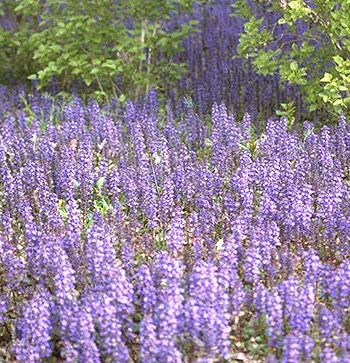Contents:
Common Names | Parts Usually Used | Plant(s) & Culture | Where Found | Medicinal Properties
Legends, Myths and Stories | Uses | Formulas or Dosages | Warning | Bibliography
Scientific Names

- Ajuga reptans L.
- Labiatae
- Mint family
Common Names
- Brown bugle
- Herb-carpenter
- Middle confound
- Middle comfrey
- Sicklewort
Parts Usually Used
Leaves
Back to Top
Description of Plant(s) and Culture
Bugle is a popular perennial groundcover for shady spots; it has a squarish stem, topped in spring and summer with tight whorls of blue flowers. The leaves from the root are stalked, those from the stem, often tinged with blue, are stalkless. After the flowering comes the small, round blackish seeds. The root is composed of many strings, and spreads on the ground. Blooms in May to July.
Other varieties: Geneva bugle (A. genevensis) is a taller species with light green, oval, toothed leaves and blue flowers; Bronze ajuga (A. reptans var. atropurpurea) has blue flowers and bronze leaves; A. reptans var. multicolor) with red, brown, and yellow foliage; Red bugle (A. reptans var. rubra) has dark purple foliage with pink flowers; and (A. reptans var. varigata) with leaves splotched and bordered with cream and blue flowers.
The white flowered bugle differs by being an evergreen, the leaves and stalks are always green, never brown. Not so plentiful as the common blue flowered plant.
Back to Top
Where Found
Herb-Carpenter is a common plant, which grows in damp woods and meadows.
Back to Top
Medicinal Properties
Narcotic
Back to Top
Legends, Myths and Stories
The roots of bugle produces a black dye.
Back to Top
Uses
One of the mildest narcotics and can be prescribed in all cases. It is a digestive, having a sedative influence on upset stomachs. Used in the treatment of tuberculosis. The bruised leaves may be applied as a poultice for cuts and wounds or bruises. Also made into an ointment. Decoction of leaves and flowers is used for cough remedy and for “hangovers”.
A decoction of leaves and flowers made in wine, helps congeal blood from bruises. Helps heal wounds, treats sores, ulcers, gangrene, mouth sores, bleeding gums, helps heal broken bones, insomnia (use the syrup of this herb for insomnia, 2 tbsp. upon retiring).
Back to Top
Formulas or Dosages
Prepare an infusion from the leaves and sweeten with honey.
Back to Top
Warning
This herb is a narcotic. Take at short intervals only and then under medical supervision.
Back to Top
Bibliography
![]() Culpeper’s Complete Herbal & English Physician: Updated With 117 Modern Herbs
Culpeper’s Complete Herbal & English Physician: Updated With 117 Modern Herbs, by Nicholas Culpeper, Meyerbooks, publisher, PO Box 427, Glenwood, Illinois 60425, 1990, (reprint of 1814)
Herbal Gardening, compiled by The Robison York State Herb Garden, Cornell Plantations, Matthaei Botanical Gardens of the University of Michigan, University of California Botanical Garden, Berkeley., Pantheon Books, Knopf Publishing Group, New York, 1994, first edition
 The Magic of Herbs
The Magic of Herbs, by David Conway, published by Jonathan Cape, Thirty Bedford Square, London, England. (Out of print)
![]() Webster’s New World Dictionary
Webster’s New World Dictionary, Third College Edition, Victoria Neufeldt, Editor in Chief, New World Dictionaries: A Division of Simon & Schuster, Inc., 15 Columbus Circle, New York, NY 10023
 The Rodale Herb Book: How to Use, Grow, and Buy Nature’s Miracle Plants (An Organic gardening and farming book)
The Rodale Herb Book: How to Use, Grow, and Buy Nature’s Miracle Plants (An Organic gardening and farming book), edited by William H. Hylton, Rodale Press, Inc. Emmaus, PA, 18049., 1974
